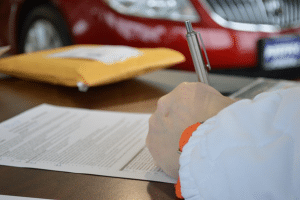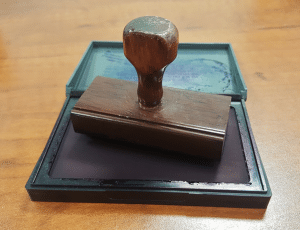Last Updated on October 27, 2025 by SLO Notary
If you’ve ever had a document notarized—say, a power of attorney, a property deed, or even a permission slip for your kid’s international trip—you’ve probably seen the notary stamp, signature, and that official-looking section at the bottom. That section is what’s called a notarial certificate. It’s not just legal fluff; it’s the notary’s written statement that they performed a specific act, under specific conditions. And you’d be surprised how many types there are, each with its own meaning and legal weight.
Let’s break them down.
The Acknowledgment – When You’re Saying, “Yep, That’s My Signature”
This is one of the most common types of notarial certificates, especially for real estate documents and business contracts. The acknowledgment basically says: “I signed this willingly, and I know what I’m signing.”
In practical terms, the signer must appear before the notary (yes, physically), present ID, and confirm that they signed the document voluntarily. The notary doesn’t care who drafted it or what it says—they’re only confirming identity and intent.
You might see wording like:
“Acknowledged before me this 5th day of May, 2025, by Jane Doe…”
It’s straightforward, but critical. Without it, that deed or agreement might not hold up in court—or be recordable at all in California.
The Jurat – Sworn Truth and Raised Right Hands
Now, this one’s a little more dramatic. A jurat is used when a signer swears (or affirms) that the contents of a document are true. Think affidavits, depositions, or sworn statements—situations where lying could lead to perjury.
Here’s what happens: the signer appears before the notary, shows valid ID, and then takes an oath or affirmation. Something like:
“Do you swear or affirm that the statements in this document are true?”
Once they say yes, they sign the document in front of the notary. Then the notary completes the jurat certificate—something along the lines of:
“Subscribed and sworn to before me this 5th day of May, 2025…”
If you’ve ever watched courtroom TV dramas, this is the notarization equivalent of “Do you swear to tell the truth, the whole truth, and nothing but the truth?”—just without the gavel and audience.
The Copy Certification – Making It Official (Again)
California notaries can certify copies of certain non-recordable documents, meaning things that aren’t kept by a government office—like diplomas, letters, or contracts. But not everything qualifies. Birth certificates, marriage licenses, and court documents? Off-limits. You’d have to go through the issuing agency for those.
The notary compares the original document with the copy, ensures it’s identical, and then signs a certificate that states it’s a “true and correct copy.” This is a lifesaver when you need to send important paperwork somewhere, but don’t want to risk losing the original.
Signature by Mark – Because Not Everyone Signs the Same Way
Here’s one that surprises people. Not everyone can sign their name due to physical limitations, age, or literacy. In such cases, California allows a “signature by mark”—like an “X.”
The notarial certificate for this includes a bit more detail: two witnesses must be present, the signer must acknowledge the mark, and the notary must add an explanatory statement. It’s a small but meaningful piece of accessibility law—ensuring that everyone, regardless of ability, can still execute important documents.
Proof of Execution by Subscribing Witness – The Backup Plan
Sometimes, the person who signed the document can’t appear before a notary later. Maybe they’re out of the country or incapacitated. In that case, a subscribing witness—someone who saw them sign—can appear before the notary instead.
This certificate is known as “proof of execution.” The notary confirms the witness’s identity and has them swear that they personally saw the original signer execute the document. However, this method can’t be used for every type of paperwork—definitely not for powers of attorney or grant deeds. It’s more of a niche fix for specific scenarios.
The Oath or Affirmation – No Paper, Just a Promise
This is the most minimal of all notarial acts. There’s no document involved—just the verbal administration of an oath or affirmation.
You’ll see this in settings like depositions or when public officials take office. The notary’s certificate (if recorded) would say something like:
“Subscribed and sworn to before me…”
It’s ceremonial but also binding. A person’s spoken oath carries legal weight, even without pen and paper.
So, Which Certificate Should You Use?
Here’s the tricky part: notaries aren’t allowed to choose the certificate for you. That would be considered “practicing law without a license.” The signer or the document’s issuing authority must specify the form.
If someone shows up saying, “I just need this notarized,” the notary’s job isn’t to decide which certificate fits—it’s to explain the differences (in plain English) and let the customer decide. It’s a fine line, but one that protects both parties from legal issues later on.
That’s also why some notaries keep loose certificates—blank acknowledgment and jurat forms—so they can attach whichever the signer requests.
Why It All Matters
It’s easy to think of notarization as a bureaucratic step—a box to tick. But these certificates represent accountability and trust. Each one is a safeguard: for the signer, for the recipient, and for the system that depends on verified documents.
Without the correct certificate, a document could be rejected, delayed, or legally useless. That’s why reputable notaries in San Luis Obispo County, like SLO Notary, take the time to make sure every line and seal is exactly where it needs to be.
And honestly, that’s what you want when you’re dealing with something that affects your finances, your property, or your family’s future. Precision with a side of professionalism.
Final Thought
Next time you visit a notary—whether it’s for a real estate transaction, a sworn statement, or just a certified copy—you’ll know there’s more to that little stamp than meets the eye. Each notarial certificate tells a story of honesty, verification, and accountability. It’s not just paperwork; it’s protection.




